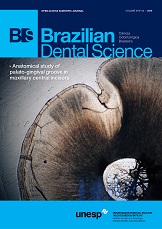Evaluation of acidulated dentifrice influence on fluoride releasing from glass-ionomer cements
DOI:
https://doi.org/10.14295/bds.2015.v18i3.1134Abstract
Objective: To evaluate the acidulated dentifrice influence on fluoride releasing from glass-ionomer cements. Methods: 27 specimens were constructed, divided into 3 groups: G1 (Maxion - R), G2 (Ketac Molar 3M/ESPE) and G3 (Vittremer 3M/ESPE), and subdivided into 3 subgroups (n = 3): A (exposure to acidulated fluoride dentifrice – pH 4.5 / 7h / 37 oC), B (exposure to non-acidulated fluoride dentifrice / 7h / 37 oC), C (control - exposure to artificial saliva). After exposing, the specimens were immersed into artificial saliva and the fluoride releasing measured at the following time periods: 1 to 14 days. Data were subjected to analysis of variance using the Statistical Package for Social Science (SPSS). ANOVA test was applied with level of significance of 5% to compare the means and the behavior of each material. Results: The exposure to acidulated dentifrice showed fluoride releasing means values (ppm/mm2) that varied from 1 and 14 days : G1A (0.269 to 0.204); G2A (0.394 to 0.038); G3A (0.080 to 0.123). The relationship among the G1 subgroups at T1 and G3 subgroups at T1 and T14 was statistically significant. Conclusion: The acidulated dentifrice positively influenced on fluoride releasing of hybrid GIC but not on that of conventional GICs.
Keywords: Glass-ionomer cement; Fluoride releasing; Acidulated dentifrice.
Downloads
Downloads
Published
How to Cite
Issue
Section
License
Brazilian Dental Science uses the Creative Commons (CC-BY 4.0) license, thus preserving the integrity of articles in an open access environment. The journal allows the author to retain publishing rights without restrictions.
=================




























